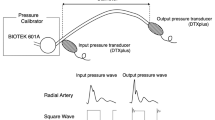Abstract
The model that describes the physical behavior of a fluid-filled catheter-transducer blood pressure monitoring system is a simple mass-spring system. When the mass is displaced and then released, there results a characteristic motion calledsimple harmonic motion. The full description of this motion requires defining the concepts of undamped and damped natural frequency, as well as of damping itself. Once these concepts are defined and the mass-spring system clearly understood, their relevance to recording blood pressure measurement by fluid-filled catheters is explained. The apparent paradox of how damping can affect undamped natural frequency is clarified. Finally, impedance matching is explained in the context of how some damping devices work. Detailed mathematical proofs are relegated to an appendix.
Similar content being viewed by others
References
Thomson WT. Theory of vibration with applications. Englewood Cliffs, NJ: Prentice-Hall, 1981:3
Caro CG, Pedley TJ, Schoter RC, Seed WA. The mechanics of the circulation. Oxford: Oxford University Press, 1978:112–113
Yang SS, Bentwoglio LG, Maranbão V, Goldberg H. From cardiac catheterization data to hemodynamic parameters. Philadelphia: Davis, 1978:10–12
Hansen AT. Pressure measurement in the human organism. Acta Physiol Scand [Suppl] 1949;19[68]:1–227
Cronvich JA, Burch GE. Frequency characteristics of some pressure transducer systems. Am Heart J 1969;77:792–797
Gardner RM. Direct blood pressure measurement—dynamic response requirements. Anesthesiology 1981;54:227–236
Patel DJ, Vaishnar RN. Basic hemodynamics and its role in disease processes. Baltimore: University Park, 1980:43
Shinozaki T, Deane RS, Mazuzan JE. The dynamic responses of liquid-filled catheter systems for direct measurement of blood pressure. Anesthesiology 1980;53:498–504
Abrams JH, Olson ML, Marino JA, Cerra FB. Use of a needle valve variable resistor to improve invasive blood pressure monitoring. Crit Care Med 1984;12:978–982
Milnor WR. Pulsatile blood flow. N Engl J Med 1972;287:27–34
Gabe IT. Pressure measurement in experimental physiology. In: Bergel DH, ed. Cardiovascular fluid dynamics. London: Academic Press, 1972:23–29
Latimer KE. The transmission of sound waves in liquid-filled catheter tubes used for intravascular blood pressure recording. Med Biol Eng Comput 1968;6:2942
Van der Tweel LH. Some physical aspects of blood pressure, pulse wave, and blood pressure measurements. Am Heart J 1957;53:4–17
Ross SL. Introduction to ordinary differential equations. London: Blaisdell, 1966:142–173
Hansen AT, Warburg E. The theory for elastic liquid-containing membrane manometers. Acta Physiol Scand 1949;19:306–331
Milnor WR. Hemodynamics. Baltimore: Williams & Wilkins, 1982:285–286
Patel DJ, Vaishnar RN. Basic hemodynamics and its role in disease processes. Baltimore: University Park, 1980:20–21
Geddes LA. The direct and indirect measurement of blood pressure. Chicago: Year Book Medical, 1970:50
Hansen AT. The theory for elastic liquid-containing membrane manometers. Acta Physiol Scand 1949;19:333–343
Vierhout RR. The response of catheter manometer systems used for direct blood pressure measurements [Thesis]. University of Nijmegen, The Netherlands: Thoben Offset, 1966:79–90.
Streeter VL, Wylie BE. Fluid mechanics. New York: McGraw-Hill, 1979:111–112, 194
Author information
Authors and Affiliations
Rights and permissions
About this article
Cite this article
Kleinman, B. Understanding natural frequency and damping and how they relate to the measurement of blood pressure. J Clin Monitor Comput 5, 137–147 (1989). https://doi.org/10.1007/BF01617889
Received:
Revised:
Accepted:
Issue Date:
DOI: https://doi.org/10.1007/BF01617889




